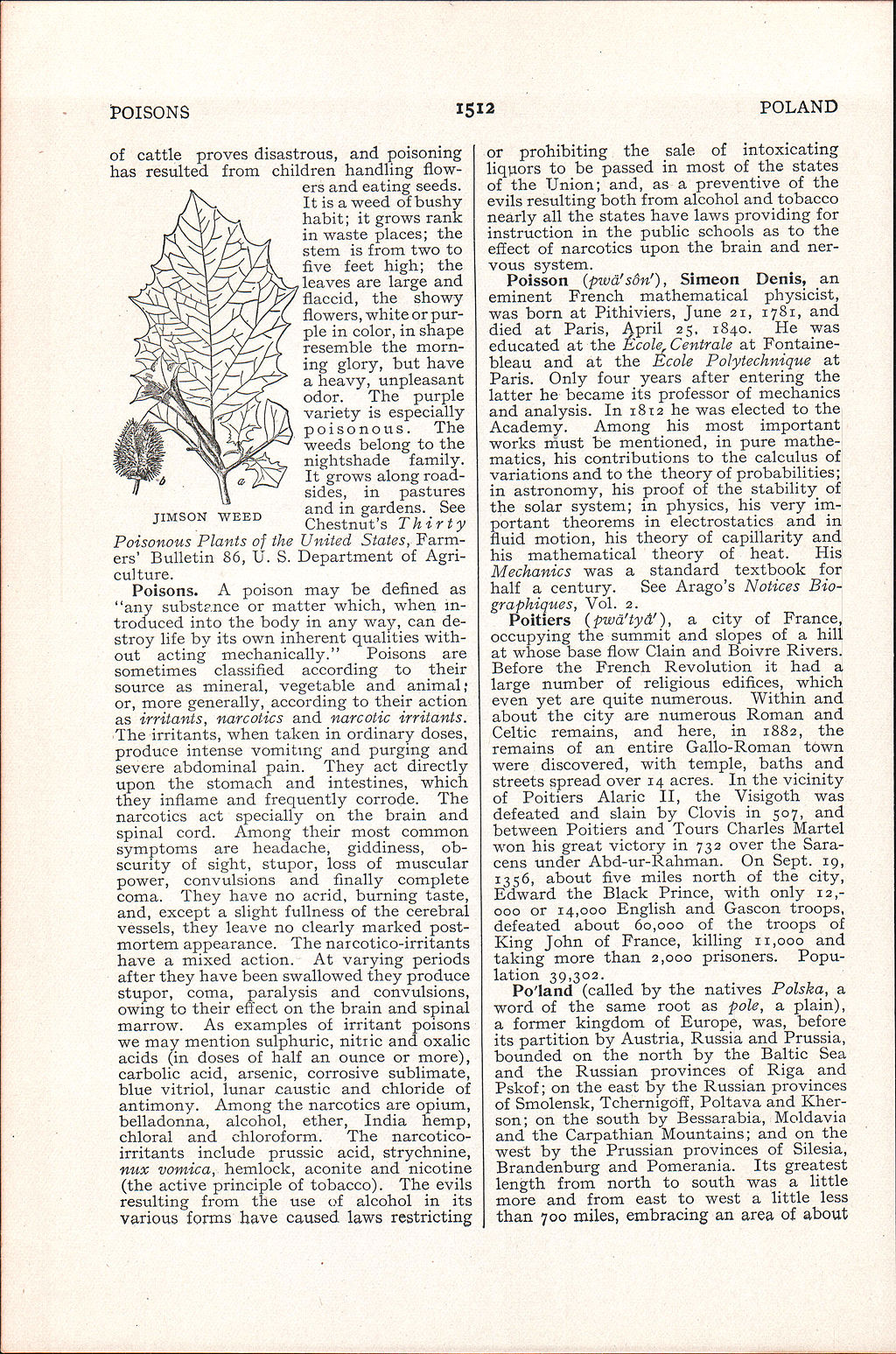Page 1512 : POISONS — POLAND
Individual articles:
of cattle proves disastrous, and poisoning has resulted from children handling flowers and eating seeds. It is a weed of bushy habit; it grows rank in waste places; the stem is from two to five feet high; the leaves are large and flaccid, the showy flowers, white or purple in color, in shape resemble the morning glory, but have a heavy, unpleasant odor. The purple variety is especially poisonous. The weeds belong to the nightshade family. It grows along roadsides, in pastures and in gardens. See Chestnut’s Thirty Poisonous Plants of the United States, Farmers’ Bulletin 86, U. S. Department of Agriculture.
Poisons. A poison may be defined as “any substance or matter which, when introduced into the body in any way, can destroy life by its own inherent qualities without acting mechanically.” Poisons are sometimes classified according to their source as mineral, vegetable and animal; or, more generally, according to their action as irritants, narcotics and narcotic irritants. The irritants, when taken in ordinary doses, produce intense vomiting and purging and severe abdominal pain. They act directly upon the stomach and intestines, which they inflame and frequently corrode. The narcotics act specially on the brain and spinal cord. Among their most common symptoms are headache, giddiness, obscurity of sight, stupor, loss of muscular power, convulsions and finally complete coma. They have no acrid, burning taste, and, except a slight fullness of the cerebral vessels, they leave no clearly marked postmortem appearance. The narcotico-irritants have a mixed action. At varying periods after they have been swallowed they produce stupor, coma, paralysis and convulsions, owing to their effect on the brain and spinal marrow. As examples of irritant poisons we may mention sulphuric, nitiic and oxalic acids (in doses of half an ounce or more), carbolic acid, arsenic, corrosive sublimate, blue vitriol, lunar caustic and chloride of antimony. Among the narcotics are opium, belladonna, alcohol, ether, India hemp, chloral and chloroform. The narcotico-irritants include prussic acid, strychnine, nux vomica, hemlock, aconite and nicotine (the active principle of tobacco). The evils resulting from the use of alcohol in its various forms have caused laws restricting or prohibiting the sale of intoxicating liquors to be passed in most of the states of the Union; and, as a preventive of the evils resulting both from alcohol and tobacco nearly all the states have laws providing for instruction in the public schools as to the effect of narcotics upon the brain and nervous system.
Poisson (pwä′sôn′), Simeon Denis, an eminent French mathematical physicist, was born at Pithiviers, June 21, 1781, and died at Paris, April 25, 1840. He was educated at the École Centrale at Fontainebleau and at the École Polytechnique at Paris. Only four years after entering the latter he became its professor of mechanics and analysis. In 1812 he was elected to the Academy. Among his most important works must be mentioned, in pure mathematics, his contributions to the calculus of variations and to the theory of probabilities; in astronomy, his proof of the stability of the solar system; in physics, his very important theorems in electrostatics and in fluid motion, his theory of capillarity and his mathematical theory of heat. His Mechanics was a standard textbook for half a century. See Arago’s Notices Biographiques, Vol. 2.
Poitiers (pwä′tyā́′), a city of France, occupying the summit and slopes of a hill at whose base flow Clain and Boivre Rivers. Before the French Revolution it had a large number of religious edifices, which even yet are quite numerous. Within and about the city are numerous Roman and Celtic remains, and here, in 1882, the remains of an entire Gallo-Roman town were discovered, with temple, baths and streets spread over 14 acres. In the vicinity of Poitiers Alaric II, the Visigoth was defeated and slain by Clovis in 507, and between Poitiers and Tours Charles Martel won his great victory in 732 over the Saracens under Abd-ur-Rahman. On Sept. 19, 1356, about five miles north of the city, Edward the Black Prince, with only 12,000 or 14,000 English and Gascon troops, defeated about 60,000 of the troops of King John of France, killing 11,000 and taking more than 2,000 prisoners. Population 39,302.
Po′land (called by the natives Polska, a word of the same root as pole, a plain), a former kingdom of Europe, was, before its partition by Austria, Russia and Prussia, bounded on the north by the Baltic Sea and the Russian provinces of Riga and Pskof; on the east by the Russian provinces of Smolensk, Tchernigoff, Poltava and Kherson; on the south by Bessarabia, Moldavia and the Carpathian Mountains; and on the west by the Prussian provinces of Silesia, Brandenburg and Pomerania. Its greatest length from north to south was a little more and from east to west a little less than 700 miles, embracing an area of about
Image: JIMSON WEED
